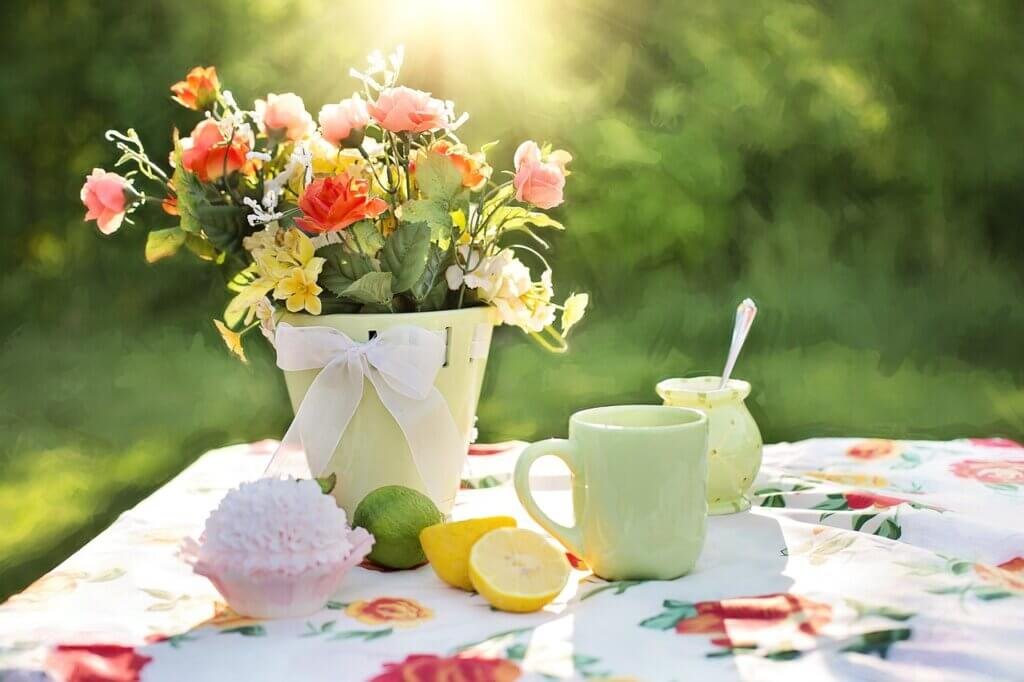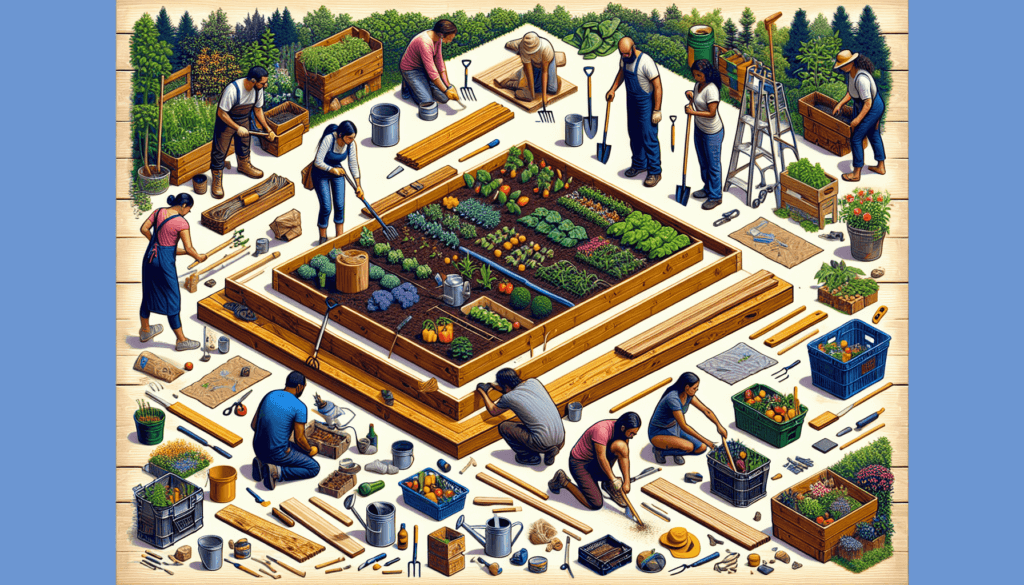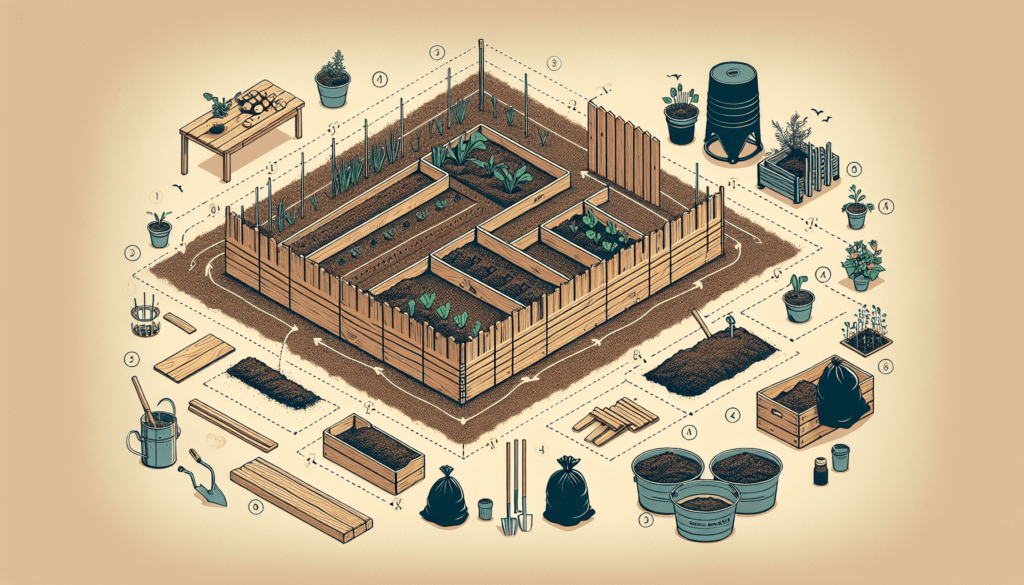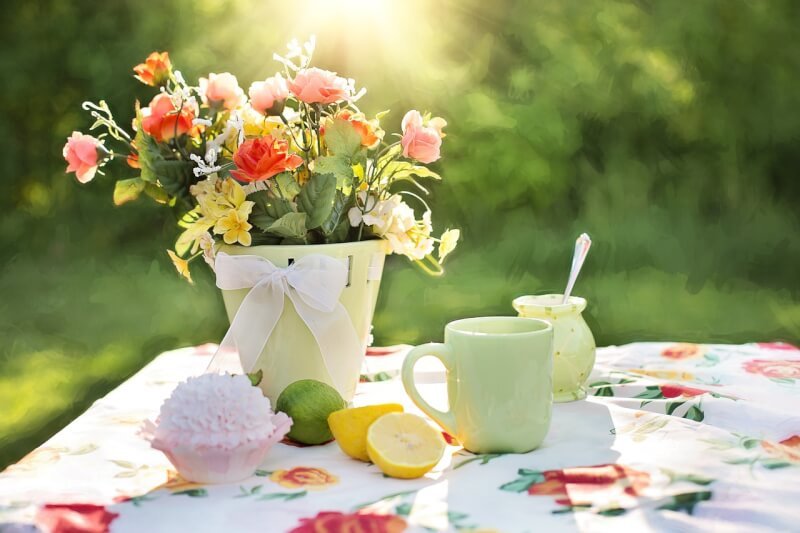If you’ve always dreamed of having your own vegetable garden but have limited space or poor soil quality, then creating a DIY raised bed garden can be the perfect solution for you. Raised bed gardens are not only practical but also provide the opportunity to grow a wide variety of plants and vegetables. In this article, you’ll discover the best ways to create your own raised bed garden, including choosing the right location, selecting the ideal materials, and implementing proper soil preparation techniques. Get ready to dig in and turn your gardening dreams into a reality!
Choosing the Right Location
Considering sunlight exposure
When selecting the location for your DIY raised bed garden, it’s important to consider the amount of sunlight the area receives. Most plants require at least six hours of direct sunlight per day to thrive. Observe the area throughout the day to determine how much sunlight it receives. Avoid areas that are heavily shaded or receive only a few hours of sunlight as this can result in poor plant growth.
Checking soil conditions
The soil conditions in the chosen location are crucial for the success of your raised bed garden. Conduct a simple soil test to determine the pH level and nutrient content of the soil. Most plants prefer a slightly acidic to neutral pH range of 6.0 to 7.0. If the soil is too alkaline or acidic, you can adjust it using amendments such as lime or sulfur. Additionally, ensure that the soil is well-draining and not compacted to prevent waterlogged conditions that can harm plant roots.
Evaluating drainage
Proper drainage is vital for the health of your plants. Select a location that has good natural drainage to avoid water accumulation in the raised bed. Heavy clay soils or areas prone to flooding should be avoided as they can lead to root rot and other water-related problems. If the chosen area has poor drainage, you can consider adding drainage components to the raised bed or implementing raised bed construction techniques that promote better water flow.
Selecting the Materials
Wooden boards
Wooden boards are a popular choice for constructing raised beds due to their versatility and availability. Cedar and redwood are excellent choices for their natural resistance to rot and longevity. When selecting wooden boards, choose untreated or naturally rot-resistant options to prevent chemical leaching into the soil. It’s recommended to use boards that are at least 6 inches in height to provide ample soil depth for plant growth.
Cinder blocks
Cinder blocks offer a cost-effective option for building raised beds. They are sturdy, durable, and easy to work with. When using cinder blocks, ensure that the hollow cavities are filled with gravel or drainage materials to prevent waterlogged soil at the base. Keep in mind that cinder blocks can absorb and retain heat, which can affect soil temperature. Consider painting the exterior of the blocks with a reflective coating to mitigate heat retention.
Composite materials
Composite materials, such as recycled plastic or composite lumber, are an eco-friendly alternative to traditional wood. These materials are resistant to rot, insect damage, and moisture, making them long-lasting choices for raised bed construction. Additionally, composite materials offer easy maintenance and don’t require sealing or staining. While they can be more expensive initially, their durability and lifespan make them a worthwhile investment.
Galvanized metal
Galvanized metal is a durable and aesthetically pleasing option for raised bed construction. Metal beds can be found in various shapes and sizes, making them suitable for different garden layouts. Keep in mind that metal can conduct heat, which can impact soil temperature. To prevent overheating, consider adding insulation or painting the sides facing the soil with a light color that reflects sunlight.

Determining the Size and Shape
Considering available space
The size of your raised bed garden depends on the available space in your yard or garden. Measure the area where you plan to construct the bed and consider factors such as walkways, access, and other existing structures that may limit the bed’s size. It’s essential to leave enough space between the beds and surrounding elements to allow for proper airflow and accessibility.
Assessing accessibility
Ensure that the dimensions of your raised bed allow easy access for gardening tasks such as planting, watering, weeding, and harvesting. A width of 2 to 4 feet is usually ideal as it allows you to reach the center of the bed without stepping into the growing area. If you have limited mobility, consider constructing raised beds with a height that allows for comfortable gardening while standing or using specialized tools.
Determining the height
The height of your raised bed garden depends on your preferences, gardening needs, and physical abilities. Raised beds can range from a few inches to several feet in height. Consider the type of plants you intend to grow and their root depth requirements. Taller beds may be suitable for vegetables with deep roots, while lower beds can accommodate shallow-rooted plants or serve as flower beds. Remember that taller beds require more soil to fill, which can impact cost and weight.
Preparing the Ground
Clearing the area
Before constructing the raised bed, clear the area of any vegetation, rocks, or debris. Remove grass, weeds, and their roots to prevent them from regrowing in the bed. Use a shovel or a garden tiller to loosen and turn over the soil to a depth of at least 6 inches. This will create a clean and fresh canvas for your raised bed garden.
Removing grass and weeds
To ensure that unwanted vegetation doesn’t make its way into your raised bed, it’s important to remove all grass and weeds thoroughly. Use a sharp-edged spade or a garden hoe to cut through the grass or weed roots and lift them out of the ground. Alternatively, you can cover the cleared area with a layer of cardboard or plywood to smother the grass and prevent regrowth.
Leveling the ground
After clearing the area and removing any unwanted vegetation, use a rake or a garden leveling tool to even out the ground. Leveling the soil surface will provide a stable base for the construction of the raised bed and ensure that the bed sits evenly. Check the level with a carpenter’s level to ensure accuracy. If necessary, add or remove soil to achieve a level surface.

Building the Raised Bed
Aligning the boards or blocks
If you are using wooden boards or cinder blocks, align them in the desired shape and size for your raised bed. Ensure that the corners are square and the sides are straight. Use a measuring tape and a level to verify that the dimensions and alignment are accurate. This step is important as it will determine the overall stability and appearance of your raised bed.
Securing the corners
To ensure the structural integrity of your raised bed, secure the corners using appropriate fasteners. For wooden bed frames, use galvanized screws or nails to attach the boards securely. If you’re using cinder blocks, consider using construction adhesive to bond the blocks together at the corners. This will prevent shifting or movement of the bed over time.
Pre-drilling and screwing or nailing
When using wooden boards, pre-drilling pilot holes before inserting screws or nails can prevent splitting of the wood. Choose screws or nails that are appropriate in length to secure the boards tightly without protruding through the sides. It’s recommended to space the fasteners at least 12 inches apart along the length of the boards for adequate support.
Using brackets or connectors
If you want additional reinforcement for your raised bed, consider using brackets or connectors at the corners. These metal accessories provide extra stability and prevent the boards from shifting or separating over time. Follow the manufacturer’s instructions for proper installation of the brackets or connectors.
Building multiple tiers
If you have enough space and want to create a visually appealing raised bed garden, consider constructing multiple tiers. Tiered raised beds add depth and dimension to your garden and can accommodate different types of plants with varying space needs. Ensure that each tier is level and properly secured to maintain stability and prevent soil erosion between the tiers.
Filling the Bed with Soil
Adding a layer of cardboard or landscape fabric
To suppress weed growth and create a barrier between the native soil and the raised bed soil, add a layer of cardboard or landscape fabric at the bottom of the bed. This will prevent weed seeds from germinating and penetrating into the raised bed while still allowing for water drainage. Ensure that the cardboard or fabric covers the entire bottom surface of the bed.
Choosing the right soil mix
Selecting the appropriate soil mix is essential for the health and productivity of your plants. Use a high-quality, well-draining soil mix specifically formulated for raised beds or containers. These mixes usually contain a blend of topsoil, compost, and organic matter, providing a balanced nutrient content and good water retention capacity. Avoid using garden soil alone, as it can be too heavy and may not drain properly in a raised bed.
Amending the soil with compost and organic matter
To enrich the soil and provide essential nutrients, add compost and organic matter to the soil mix. Compost is rich in beneficial microorganisms and provides a slow-release source of nutrients for the plants. Mix in composted manure, leaf mold, or other organic amendments to improve soil structure and fertility. Incorporate these materials evenly into the bed, ensuring they are well-distributed throughout the soil mix.
Leveling and firming the soil
After filling the raised bed with the soil mix, use a rake or a gardening tool to level the soil surface. Ensure that the soil is evenly distributed and fills the bed to the desired height. Gently firm the soil by lightly pressing it down to eliminate any air pockets. This will provide a stable base for planting and promote better root growth and water retention.

Planting and Watering
Selecting suitable plants
The selection of plants for your raised bed garden depends on your personal preferences and the growing conditions of your location. Consider factors such as the amount of sunlight the bed receives, the soil pH, and the available space. Choose plants that have similar sun, soil, and water requirements to ensure they thrive together. Popular choices for raised bed gardens include vegetables, herbs, flowers, and small fruiting plants.
Spacing and arranging plants
Proper spacing and arrangement of plants are vital to maximize their growth potential. Check the specific spacing recommendations for each plant variety and ensure that you provide enough room for growth. Place taller plants at the back or center of the bed to prevent shading of shorter plants. Consider companion planting to promote natural pest control and improve overall garden health.
Providing adequate watering
Watering is a crucial aspect of maintaining a raised bed garden. Monitor the moisture level of the soil regularly and water accordingly to ensure plants receive adequate hydration. Raised beds tend to dry out more quickly than traditional garden beds, so be attentive to dry conditions. Water deeply and thoroughly, ensuring that the water reaches the root zone of the plants.
Installing a drip irrigation system
To simplify the watering process and ensure consistent moisture, consider installing a drip irrigation system in your raised bed garden. Drip irrigation delivers water directly to the plant roots, minimizing water wastage and reducing the risk of fungal diseases. There are various types of drip irrigation systems available, ranging from simple soaker hoses to programmable timers for automated watering.
Mulching to conserve moisture
To conserve moisture and suppress weed growth, apply a layer of organic mulch around your plants. Mulch acts as a protective barrier, reducing evaporation and maintaining soil moisture levels. Use organic materials such as straw, wood chips, or shredded leaves as mulch. Apply a layer about 2-3 inches thick around the plants, keeping the mulch clear of the plant stems to prevent rotting.
Maintaining the Raised Bed
Weeding regularly
Regular weeding is crucial to prevent unwanted plants from competing with your desired plants for nutrients, water, and sunlight. Inspect the raised bed regularly for any weed growth and remove them promptly. Hand-pulling weeds is generally the safest and most effective method in a raised bed to prevent disturbing the roots of your plants.
Mulching to control weeds
In addition to removing weeds, applying mulch can help suppress weed growth in your raised bed. The layer of mulch acts as a physical barrier, preventing weed seeds from reaching the soil and germinating. It also reduces the amount of light that weed seedlings receive, inhibiting their growth. Keep the mulch layer regularly replenished to maintain its effectiveness in controlling weeds.
Monitoring moisture levels
Regularly monitor the moisture levels in your raised bed garden to ensure that your plants are neither underwatered nor overwatered. Insert your finger into the soil about an inch or two deep to check if it feels moist. Adjust your watering frequency and duration depending on the weather conditions and the specific needs of your plants.
Applying organic fertilizers
To provide essential nutrients for your plants, apply organic fertilizers throughout the growing season. Organic fertilizers such as compost, worm castings, or well-rotted manure are excellent choices as they release nutrients slowly and improve soil fertility over time. Follow the recommended application rates based on the fertilizer package instructions, adjusting as needed for the specific plant requirements.
Pruning and harvesting
Regular pruning and harvesting are essential for maintaining the health and productivity of your raised bed garden. Remove any dead, damaged, or diseased plant parts to prevent the spread of diseases and maintain the overall appearance of the garden. Harvest mature fruits and vegetables promptly to encourage further production and prevent overripe or spoiled produce.

Pest Control
Identifying common garden pests
Garden pests can be a challenge in any garden, including raised bed gardens. Learn to identify common garden pests, such as aphids, slugs, snails, caterpillars, and beetles. Look for signs of pest damage, including chewed leaves, holes in fruits, or distorted growth. Regularly inspect your plants for any pest infestations to catch them early and prevent significant damage.
Implementing natural pest control methods
When dealing with garden pests in your raised bed, it’s best to start with natural pest control methods before resorting to chemical interventions. Encourage beneficial insects, such as ladybugs and lacewings, by planting companion flowers that attract them. Use physical barriers like netting or mesh to protect vulnerable plants from pests. Handpick pests when possible and consider natural remedies like homemade insecticidal soaps or oil sprays.
Using physical barriers
Physical barriers can effectively deter pests from accessing your plants. Use row covers or mesh netting to create a protective barrier over your raised bed. These covers allow air, light, and water to reach the plants while keeping pests out. Be sure to secure the covers tightly to prevent pests from finding their way inside.
Using organic insecticides as a last resort
If natural pest control methods prove insufficient, organic insecticides can be used as a last resort. Choose insecticides derived from natural sources, such as neem oil or pyrethrin. Follow the instructions on the product labels carefully and use them sparingly. Be cautious when applying insecticides to not harm beneficial insects or pollinators.
Extending the Growing Season
Covering the bed with a hoop or cold frame
To extend the growing season and protect plants from early frost or cold temperatures, consider covering your raised bed with a hoop or a cold frame. Hoops are bendable metal or plastic structures that can be secured over the bed and covered with a light fabric or plastic sheet. Cold frames are enclosed structures with transparent lids that capture heat from the sun and provide insulation. Both options create a microclimate within the raised bed, allowing you to grow cold-tolerant crops for a longer time.
Using row covers or cloches
Row covers and cloches are smaller-scale options for protecting individual plants or rows within the raised bed. Row covers are lightweight, permeable fabrics that can be draped over plants and secured with stakes or clips. Cloches are individual protective covers that can be placed directly over plants. Both options provide insulation and protect plants from frost, wind, and pests.
Installing a temporary greenhouse
For those looking to maximize the growing season and create a more controlled environment, consider installing a temporary greenhouse over your raised bed. A greenhouse provides protection from extreme temperatures and allows you to create optimal growing conditions. There are various greenhouse kits available that can be easily assembled and disassembled seasonally.
Adding heat sources
In colder climates or during particularly harsh winters, adding heat sources to your raised bed can help maintain the necessary warmth for plant growth. Electric heating mats, heat cables, or small heaters specifically designed for greenhouse use can provide supplementary heat. Ensure that the chosen heat source is safe, properly wattaged, and used according to manufacturer guidelines to avoid fire hazards or damage to the plants.
Creating a DIY raised bed garden can be a rewarding and fulfilling project. By considering the location, materials, size, and shape, as well as following proper preparation and maintenance techniques, you can enjoy a thriving garden filled with healthy plants. Remember to choose suitable plants, implement pest control measures, and explore options for extending the growing season to maximize your garden’s potential. Happy gardening!



